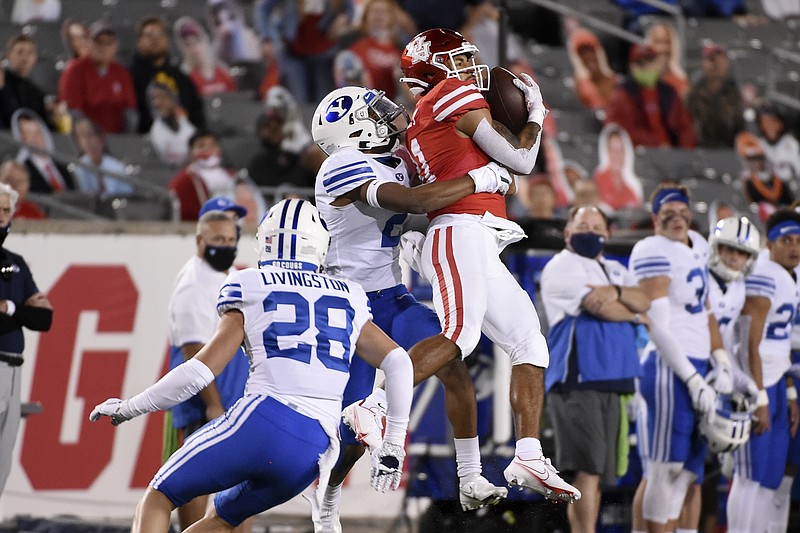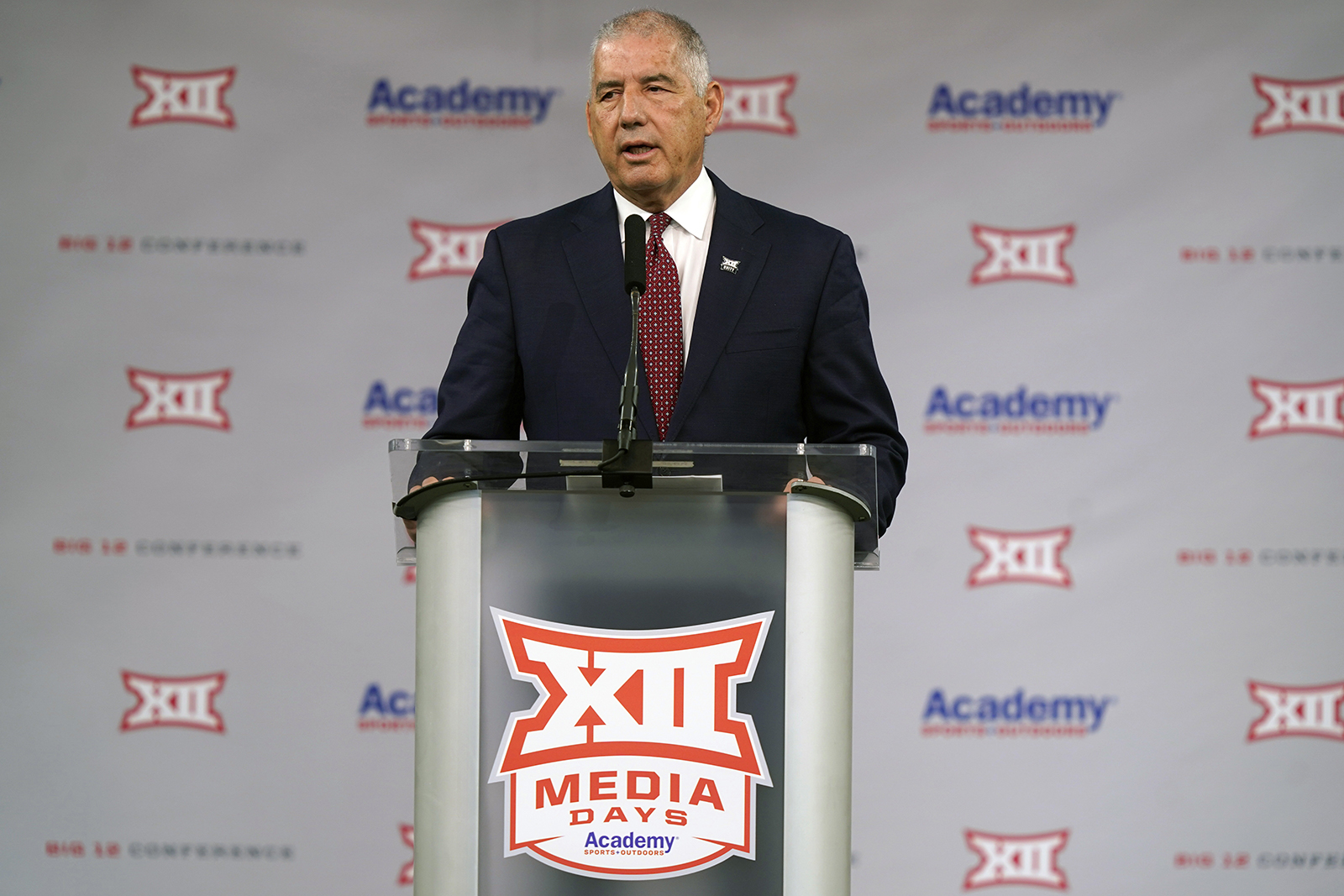With Oklahoma and Texas on their way out, the Big 12 announced Friday that it has invited Brigham Young University, the University of Central Florida, Cincinnati and Houston to join the conference.
The eight continuing members of the Big 12 unanimously approved applications from the four schools that sought membership after the league learned the Sooners and the Longhorns will leave for the Southeastern Conference no later than July 2025. Formal approval of the invitations was pending on some campuses, but the expansion is all but done.
In fact, BYU said its teams in all sports will begin Big 12 schedules in the 2023-24 athletic season. BYU is an independent program in football, but the Cougars compete in the West Coast Conference for basketball and other sports. WCC commissioner Gloria Nevarez said BYU had been transparent "in exploring opportunities to find league affiliation for its football program and has been presented with an opportunity that fits its needs."
Big 12 commissioner Bob Bowlsby said Cincinnati, Houston and UCF - all currently in the American Athletic Conference - will join no later than July 1, 2024, but he "certainly wouldn't foreclose" on the possibility of them coming in a year earlier with BYU. The AAC requires members to give 27 months' notice if they plan to leave, though there could be negotiations between the schools and the conference to reduce that time.
AAC commissioner Mike Aresco said he expected the exiting trio to "abide by the conference bylaws to ensure an amicable and orderly transition" as the conference considers its options during a period when major college football is undergoing the type of realignment that dominated the first half of the past decade.
The top tier of Division I, the Football Bowl Subdivision, is made up of 10 conferences. The Atlantic Coast Conference, Big 12, Big Ten, Pac-12 and SEC are commonly referred to as the Power Five, with the AAC, Conference USA, Mid-American Conference, Mountain West Conference and Sun Belt Conference known as the Group of Five.
The advent of the College Football Playoff starting with the 2014 season has illustrated the divide between the two tiers of the FBS, with no Group of Five team having ever made the four-team bracket. UCF is one of the programs that believes it has been unfairly overlooked in that process despite on-field success, with the Knights left out in 2017 and 2018 despite being 12-0 when the CFP made its selections.
On Friday, Aresco found an upside to the AAC's impending vacancies.
"Today's news confirms what we have said all along regarding our status as a power conference," the commissioner said. "The irony that three of our schools are being asked to take the place of the two marquee schools which are leaving the Big 12 is not lost on us. Our conference was targeted for exceeding expectations in a system that wasn't designed to accommodate our success."
After identifying its primary expansion targets last week, the Big 12 moved quickly to make it happen. The four schools had previously been vetted and were among 11 interviewed by the league in 2016 when it considered expansion before staying at 10 teams.
Bowlsby described that process five years ago as "a voyage of exploration" but said the decision by Oklahoma and Texas this summer to leave for the SEC prompted renewed consideration of available options. He also said the league could someday be open to further expansion.
Kevin Worthen, BYU's school president, said the Big 12's expansion study five years ago made the process much faster and easier this time. Cougars athletic director Tom Holmoe said that failed attempt to get into the Big 12 turned out to be a "launching point."
Oklahoma and Texas have said they will honor their current contracts with the Big 12 and do not plan to join the SEC until 2025, when the conference's current television rights contracts with ESPN and Fox run out. If the Longhorns and Sooners stay, the Big 12 could have up to 14 members for at least a season or two.
"We are were living in a very fast-changing athletic environment, and we will be at 14 for a while," Bowlsby said. "We'll drop back to 12, and as there are targets of opportunity or as there are situations that dictate that we would change composition, we'll be prepared to do those things."
With the additions, the Big 12 will be spread across eight states and three time zones. There are more than 2,300 miles between the UCF campus in Orlando and BYU in Provo, Utah. Once settled in the Big 12, they will both face average trips of close to 1,300 miles each way for conference games.
West Virginia still will average about 1,100 miles each way on the road, but the Mountaineers at least picked up a relatively short trip from Morgantown with Cincinnati on board. Houston faces much shorter trips for its Texas-based foes.
"Joining the Big 12 Conference is a historic step in our institutional journey and signifies the tremendous growth and success attained academically and athletically over the last decade," said Renu Kahtor, Houston's chancellor.
Half the league's 12 charter members will remain when Oklahoma and Texas are gone.
The Big 12 began play in 1996, when all Big Eight teams (Colorado, Iowa State, Kansas, Kansas State, Missouri, Nebraska, Oklahoma and Oklahoma State) joined four Texas schools from the old Southwest Conference (Baylor, Texas, Texas A&M and Texas Tech) to form a new league split into six-team divisions.
Arkansas left the SWC a few years earlier to join an expanded 12-team SEC, starting play there with South Carolina in the 1992 season. The SEC is now set to grow to 16 teams, with its most recent four additions all coming from the Big 12.
The Big 12 has been a 10-team league since the last significant round of realignment a decade ago that started with Nebraska going to the Big Ten and Colorado to the Pac-12, before Texas A&M and Missouri left for the SEC. Texas Christian University and West Virginia are both now in their 10th Big 12 season.

